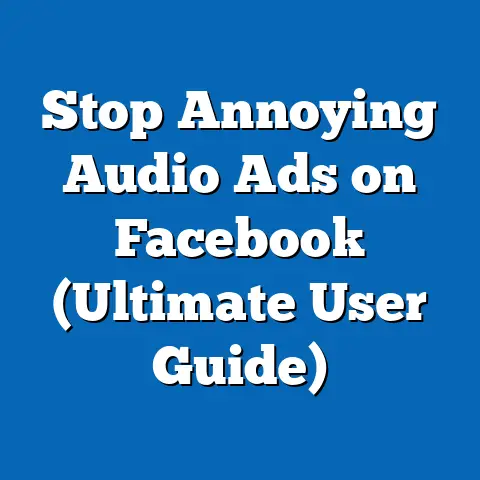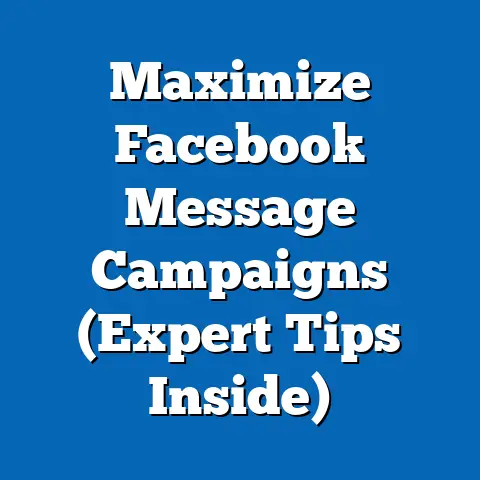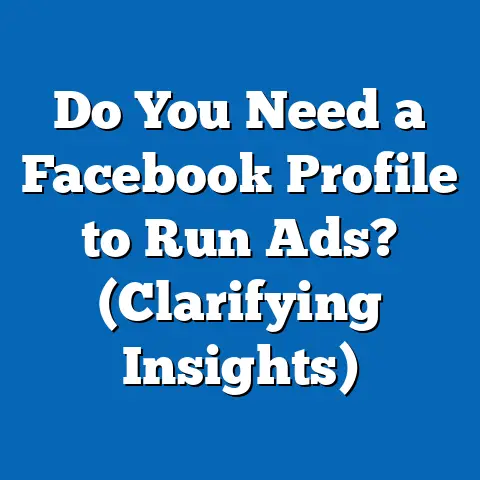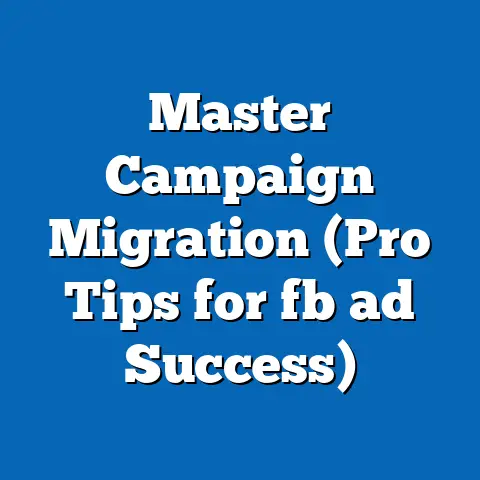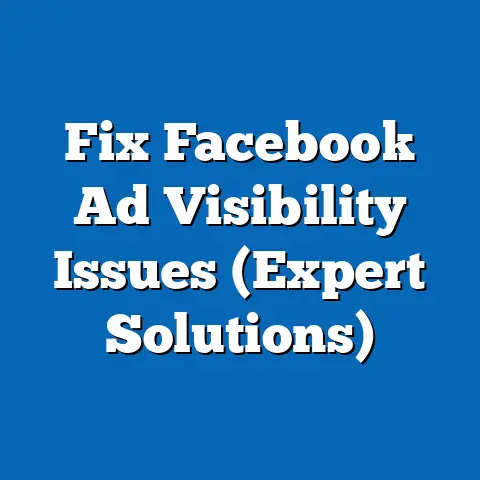Mastering Ad Payments on Facebook (Unlock Hidden Strategies)
Facebook advertising is a powerhouse for businesses, offering unparalleled reach and targeting capabilities. But let’s be honest, navigating the world of ad payments can feel like deciphering a complex code. It’s not just about slapping down a credit card and hoping for the best. It’s about understanding the nuances, optimizing your spending, and ultimately, maximizing your return on investment (ROI). And here’s a concept I want to introduce that often gets overlooked: the “resale value” of your Facebook ad expertise.
Think about it. If you’re an agency or a freelancer, your ability to consistently deliver results for clients through effective Facebook ad management is a valuable asset. Mastering ad payments, understanding cost optimization, and demonstrating a proven track record directly translates to a higher “resale value” – whether you’re looking to attract new clients, scale your business, or even sell your agency down the line. It’s about building a reputation for efficiency and results, and that starts with understanding how your ad dollars are being spent.
So, what do I mean by “resale value” and “ad payments” in this context?
- Resale Value: In the context of Facebook ads, I define “resale value” as the perceived worth of your expertise in managing and optimizing Facebook ad campaigns. This includes your ability to generate positive ROI, effectively manage budgets, and demonstrate a clear understanding of ad payment strategies. For agencies and freelancers, this translates to higher client acquisition rates, premium pricing, and potentially, a higher valuation if they choose to sell their business.
- Ad Payments: Ad payments refer to the entire process of funding your Facebook ad campaigns, including selecting payment methods, understanding billing cycles, managing payment thresholds, and optimizing your ad spend to achieve the best possible results.
Let’s get started on the journey to mastering Facebook ad payments!
Section 1: Understanding Facebook Ad Payments
The foundation of any successful Facebook ad campaign lies in understanding how the payment system works. It’s more than just entering your credit card details; it’s about understanding the mechanics that drive the entire process.
At its core, Facebook ad payments revolve around a few key elements:
- Billing Methods: Facebook offers various payment options to suit different business needs. The most common include credit cards (Visa, Mastercard, American Express), debit cards, PayPal, and in some regions, direct debit or local payment methods.
- Payment Thresholds: This is the amount of ad spend that triggers a charge to your chosen payment method. Facebook sets an initial threshold, and as you consistently pay your bills on time, this threshold may increase, allowing you to spend more before being charged.
- Billing Cycles: Facebook typically bills you either when you reach your payment threshold or at the end of the month, whichever comes first. Understanding this cycle is crucial for budgeting and forecasting.
Choosing the Right Payment Method:
The selection of your payment method is more important than you might think. While convenience is a factor, consider these points:
- Credit Cards: Often the easiest to set up and offer potential rewards points or cashback. However, be mindful of your credit limit and interest rates.
- Debit Cards: A good option if you prefer to directly debit your bank account. Ensure you have sufficient funds to avoid declined payments, which can halt your campaigns.
- PayPal: Provides an extra layer of security and can be a convenient option for businesses already using PayPal for other transactions.
- Facebook Ad Credits: These are promotional credits that Facebook sometimes offers to new advertisers or as incentives. They can be a great way to test campaigns or offset initial costs.
Why an Efficient Payment Method Matters:
Imagine launching a highly anticipated campaign, only to have it abruptly paused because of a payment issue. This is a nightmare scenario that can be easily avoided by proactively managing your payment settings.
- Campaign Continuity: A reliable payment method ensures your ads run without interruption, maximizing your reach and impact.
- Budget Management: Understanding your billing cycle allows you to accurately track your ad spend and stay within your budget.
- Building Trust with Facebook: Consistently paying your bills on time builds a positive payment history, which can lead to increased payment thresholds and access to other features.
My Experience: I remember once working with a client who was experiencing inconsistent ad performance. After digging deeper, I discovered their primary issue was that their credit card was frequently being declined due to a low credit limit. This resulted in campaigns being paused and restarted sporadically, disrupting the learning phase and negatively impacting results. By switching to a debit card linked to a business account with ample funds, we were able to stabilize their ad performance and significantly improve their ROI.
Takeaway: Take the time to carefully select and set up your Facebook ad payment method. Ensure it’s reliable, linked to an account with sufficient funds, and that you understand your billing cycle. This simple step can save you headaches and significantly improve your campaign performance.
Section 2: The Cost of Advertising on Facebook
Understanding the cost of advertising on Facebook is like understanding the stock market – there are many factors at play, and the price can fluctuate. It’s not a fixed rate; it’s a dynamic system influenced by a variety of elements.
Let’s break down the key factors that determine how much you’ll pay for your Facebook ads:
- Bidding Strategies: This is how you tell Facebook how much you’re willing to pay for each ad interaction.
- Automatic Bidding: Facebook automatically sets your bids to get the most results for your budget. This is a good option for beginners.
- Manual Bidding: You set your own bids, giving you more control but requiring a deeper understanding of the auction dynamics.
- Audience Targeting: The more specific and niche your audience, the higher the cost tends to be. Broad audiences are generally cheaper but may result in lower conversion rates.
- Ad Placements: Where your ad appears (Facebook News Feed, Instagram Stories, Audience Network, etc.) impacts the cost. Some placements are more competitive and therefore more expensive.
- Ad Quality and Relevance: Facebook rewards high-quality, relevant ads with lower costs and better placement. This is determined by factors like engagement rate, click-through rate (CTR), and feedback from users.
- Seasonality and Competition: During peak seasons like holidays, or when there’s increased competition in your industry, ad costs tend to rise.
- Automatic Bidding: Facebook automatically sets your bids to get the most results for your budget. This is a good option for beginners.
- Manual Bidding: You set your own bids, giving you more control but requiring a deeper understanding of the auction dynamics.
Key Metrics to Understand:
To effectively manage your ad spend, you need to understand these key metrics:
- Cost-Per-Click (CPC): The amount you pay each time someone clicks on your ad. This is a good metric for driving traffic to your website.
- Cost-Per-Impression (CPM): The amount you pay for every 1,000 times your ad is shown. This is useful for brand awareness campaigns.
- Cost-Per-Action (CPA): The amount you pay for each desired action, such as a purchase, lead generation, or app install. This is the most ROI-focused metric.
Leveraging Metrics for Optimization:
The beauty of Facebook advertising is that it’s highly measurable. By tracking these metrics, you can identify areas for improvement and optimize your campaigns for better results.
- High CPC, Low Conversion Rate: This suggests your ad copy or landing page isn’t compelling enough. Experiment with different messaging or improve your landing page design.
- High CPM, Low CTR: This indicates your ad creative isn’t resonating with your audience. Try different visuals or targeting options.
- High CPA: This means you’re paying too much for each desired action. Analyze your entire funnel, from ad to landing page to checkout process, to identify bottlenecks.
Real-World Example: I once worked with an e-commerce client who was struggling with high CPA. After analyzing their data, I discovered that their mobile conversion rate was significantly lower than their desktop conversion rate. By optimizing their mobile landing page and creating mobile-specific ads, we were able to dramatically reduce their CPA and increase their overall sales.
Takeaway: The cost of advertising on Facebook is a dynamic equation. By understanding the factors that influence costs and tracking key metrics, you can optimize your campaigns for maximum ROI. Don’t be afraid to experiment and adjust your strategies based on data.
Section 3: Hidden Strategies for Optimizing Ad Payments
Now, let’s move beyond the basics and dive into some hidden strategies that can truly unlock the potential of your Facebook ad payments. These strategies require a deeper understanding of the platform and a willingness to experiment.
Here are some advanced tactics I’ve found particularly effective:
1. Budgeting Smartly:
It’s not just about setting a budget; it’s about setting the right budget and managing it effectively.
- Start Small, Scale Gradually: Don’t blow your entire budget on a single campaign. Start with a small daily budget and gradually increase it as you see positive results.
- Lifetime vs. Daily Budgets: Understand the difference and choose the option that best suits your campaign goals. Lifetime budgets are ideal for campaigns with a specific end date, while daily budgets are better for ongoing campaigns.
- Budget Pacing: Monitor how quickly your budget is being spent. If it’s being depleted too quickly, consider narrowing your targeting or lowering your bids.
2. Utilizing the Facebook Pixel:
The Facebook Pixel is a small piece of code that you install on your website to track user behavior. It’s a game-changer for optimizing your ad spend.
- Conversion Tracking: The Pixel allows you to track which ads are driving conversions, giving you valuable insights into what’s working and what’s not.
- Retargeting: You can use the Pixel to retarget users who have visited your website but haven’t made a purchase. This is a highly effective way to increase conversions.
- Lookalike Audiences: The Pixel can help you create lookalike audiences, which are audiences that share similar characteristics with your existing customers. This expands your reach to potential customers who are more likely to convert.
3. Experimenting with Campaign Objectives:
Facebook offers a variety of campaign objectives, each designed to achieve a specific goal.
- Brand Awareness: Ideal for reaching a broad audience and increasing brand recognition.
- Traffic: Designed to drive traffic to your website or landing page.
- Engagement: Focuses on generating likes, comments, and shares on your posts.
- Leads: Aims to collect leads through lead generation forms.
- Conversions: Optimized for driving sales or other desired actions on your website.
Choosing the right objective is crucial for optimizing your ad spend. For example, if your goal is to drive sales, using a “Brand Awareness” objective is unlikely to be effective.
4. Leveraging A/B Testing:
A/B testing involves creating multiple versions of your ads and testing them against each other to see which performs best.
- Test Different Headlines, Images, and Body Copy: Experiment with different elements of your ad to see what resonates most with your audience.
- Test Different Targeting Options: Try different audience demographics, interests, and behaviors to see which yields the best results.
- Test Different Ad Placements: See which placements (Facebook News Feed, Instagram Stories, etc.) deliver the highest ROI.
Case Study: I recently worked with a subscription box company that was struggling to acquire new customers through Facebook ads. By implementing A/B testing, we discovered that ads featuring user-generated content (photos and videos from existing customers) significantly outperformed ads featuring professionally produced content. This insight allowed us to shift our strategy and dramatically increase their customer acquisition rate.
Takeaway: These hidden strategies require a commitment to experimentation and data analysis. But the rewards can be significant. By budgeting smartly, utilizing the Facebook Pixel, experimenting with campaign objectives, and leveraging A/B testing, you can unlock the full potential of your Facebook ad payments and achieve a much higher ROI.
Section 4: Common Pitfalls and How to Avoid Them
Even with the best strategies in place, it’s easy to fall into common pitfalls that can drain your budget and hinder your results. Recognizing these mistakes and proactively addressing them is crucial for long-term success.
Here are some common traps I’ve seen advertisers fall into:
- Poor Targeting: Targeting too broad of an audience, or targeting the wrong audience altogether, is a surefire way to waste your ad spend.
- Solution: Invest time in researching your ideal customer and creating highly targeted audiences based on demographics, interests, behaviors, and custom audiences.
- Not Utilizing Ad Scheduling: Running your ads at all hours of the day, even when your target audience is least active, is inefficient.
- Solution: Use ad scheduling to run your ads only during the times when your target audience is most likely to be online and engaged.
- Failing to Monitor Performance: Setting up a campaign and then forgetting about it is a recipe for disaster.
- Solution: Regularly monitor your ad performance, track key metrics, and make adjustments as needed.
- Ignoring Ad Fatigue: Showing the same ad to the same audience over and over again can lead to ad fatigue, where people start to tune out your ads.
- Solution: Regularly refresh your ad creative and targeting to keep your ads fresh and engaging.
- Neglecting Mobile Optimization: In today’s mobile-first world, neglecting to optimize your ads for mobile devices is a major mistake.
- Solution: Ensure your ads are mobile-friendly, your landing pages are optimized for mobile, and consider creating mobile-specific ads.
- Solution: Invest time in researching your ideal customer and creating highly targeted audiences based on demographics, interests, behaviors, and custom audiences.
- Solution: Use ad scheduling to run your ads only during the times when your target audience is most likely to be online and engaged.
- Solution: Regularly monitor your ad performance, track key metrics, and make adjustments as needed.
- Solution: Regularly refresh your ad creative and targeting to keep your ads fresh and engaging.
- Solution: Ensure your ads are mobile-friendly, your landing pages are optimized for mobile, and consider creating mobile-specific ads.
Actionable Strategies to Mitigate Pitfalls:
- Regular Analysis: Schedule time each week to review your ad performance and identify areas for improvement.
- A/B Testing: Continuously test different ad variations to optimize your creative and messaging.
- Audience Refinement: Regularly review and refine your targeting to ensure you’re reaching the right audience.
- Stay Updated: Keep up-to-date with the latest Facebook advertising features and best practices.
My Mistake: Early in my career, I launched a campaign for a local restaurant without properly researching their target audience. I assumed everyone in the area would be interested in their food, so I targeted a very broad geographic area. As a result, I wasted a significant portion of their budget on reaching people who were unlikely to ever visit their restaurant. This taught me the importance of thorough audience research and precise targeting.
Takeaway: Avoiding these common pitfalls requires vigilance and a commitment to continuous improvement. By proactively monitoring your campaigns, analyzing your data, and staying up-to-date with best practices, you can minimize wasted ad spend and maximize your ROI.
Section 5: The Future of Facebook Ad Payments
The world of Facebook advertising is constantly evolving, and the way we manage ad payments is no exception. As technology advances and user behavior shifts, we can expect to see significant changes in the years to come.
Here are some upcoming trends and potential changes I’m keeping an eye on:
- Increased Automation: Facebook is investing heavily in automation, using AI and machine learning to optimize ad campaigns and simplify the payment process. We can expect to see more automated bidding options, budget management tools, and reporting features.
- AI-Powered Ad Management: AI is already playing a role in ad targeting and creative optimization, and this trend is likely to accelerate. AI-powered tools will help advertisers create more personalized ads, identify high-potential audiences, and optimize their ad spend in real-time.
- Integration with Cryptocurrency: While still in its early stages, there’s potential for Facebook to integrate with cryptocurrency, allowing advertisers to pay for ads using digital currencies. This could offer benefits such as lower transaction fees and increased transparency.
- Focus on Privacy and Transparency: As concerns about data privacy continue to grow, Facebook is likely to place greater emphasis on transparency and user control. This could lead to changes in ad targeting options and the way ad payments are processed.
How These Changes Might Impact Advertisers:
- Increased Efficiency: Automation and AI will streamline the ad management process, freeing up time for advertisers to focus on strategy and creative.
- More Personalized Ads: AI-powered tools will enable advertisers to create more personalized ads that resonate with individual users.
- Greater Accountability: Increased transparency will require advertisers to be more accountable for their ad spend and the data they collect.
Staying Informed:
The key to navigating these changes is to stay informed and adapt your strategies accordingly. Follow industry blogs, attend webinars, and experiment with new features as they become available.
My Prediction: I believe that in the near future, we’ll see a shift towards more outcome-based pricing models, where advertisers only pay when they achieve a specific result, such as a sale or a lead. This will require greater transparency and accountability but will ultimately lead to more efficient and effective advertising.
Takeaway: The future of Facebook ad payments is dynamic and uncertain, but by staying informed, embracing new technologies, and focusing on transparency and accountability, advertisers can position themselves for success.
Conclusion
Mastering ad payments on Facebook is not just about understanding the technical aspects of billing and budgeting; it’s about strategically managing your ad spend to maximize ROI and, ultimately, increase the “resale value” of your marketing skills and services.
Throughout this guide, we’ve explored the fundamentals of Facebook ad payments, delved into hidden strategies for optimization, addressed common pitfalls to avoid, and speculated on the future of the platform.
Key Takeaways:
- Choose a reliable payment method and understand your billing cycle.
- Track key metrics to optimize your ad spend.
- Utilize the Facebook Pixel to track conversions and retarget users.
- Experiment with different campaign objectives and A/B test your ads.
- Avoid common pitfalls such as poor targeting and neglecting mobile optimization.
- Stay informed about upcoming trends and platform updates.
By implementing the strategies shared in this article, you can unlock your full potential in Facebook advertising, drive better results for your clients, and increase the perceived value of your expertise.
Now, I encourage you to take proactive steps in implementing these strategies. Start by reviewing your current ad payment settings, analyzing your ad performance, and experimenting with new targeting options. The journey to mastering Facebook ad payments is a continuous process, but the rewards are well worth the effort.
Call to Action:
I’d love to hear about your own experiences with Facebook ad payments. Share your tips, challenges, and successes in the comments section below! Let’s learn from each other and build a community of savvy Facebook advertisers.

